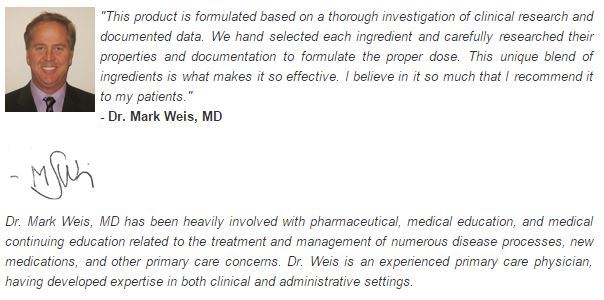Jointlax™ is a breakthrough proprietary solution that effectively combines the most powerful and extensively researched ingredients to give you an all-in-one solution for joint comfort and mobility. Every single ingredient in Jointlax™ was hand-picked by medical doctors and scientific researchers, based on the up-to-date science, and formulated to achieve faster results than any other joint care product available. Jointlax's key ingredients have been clinically proven for their restorative health benefits. The proprietary blend of vitamins, minerals, and herbs is what makes Jointlax™ so effective. By taking only 3 tablets a day, you can find the relief you seek.
 Glucosamine Sulfate has been studied in multiple clinical trials and has been shown to significantly improve pain and joint function in patients with arthritis. Glucosamine appears to stimulate the function of normal cells and tissues in the affected joints. Patients on blood thinners should consult a qualified health professional.
Glucosamine Sulfate has been studied in multiple clinical trials and has been shown to significantly improve pain and joint function in patients with arthritis. Glucosamine appears to stimulate the function of normal cells and tissues in the affected joints. Patients on blood thinners should consult a qualified health professional.
*References:
- Towheed TE, Maxwell L, Anastassiades TP, et al. Glucosamine therapy for treating osteoarthritis. Cochrane Database Syst Rev 2005;(2):CD002946
- Herrero-Beaumont G, Ivorra JA, Del Carmen Trabado M, et al. Glucosamine sulfate in the treatment of knee osteoarthritis symptoms: a randomized, double-blind, placebo-controlled study using acetaminophen as a side comparator. Arthritis Rheum 2007;56:555-67.
- McAlindon T, Formica M, LaValley M, et al. Effectiveness of glucosamine for symptoms of knee osteoarthritis: results from an internet-based randomized double-blind controlled trial. Am J Med 2004;117:643-9.
- Reginster JY, Deroisy R, Rovati LC, et al. Long-term effects of glucosamine sulfate on osteoarthritis progression: a randomized, placebo-controlled trial. Lancet 2001;357:251-6.
 Methylsulfonylmethane (MSM) has also been shown to work synergistically with glucosamine sulfate to reduce both the pain and swelling associated with arthritic joints.
Methylsulfonylmethane (MSM) has also been shown to work synergistically with glucosamine sulfate to reduce both the pain and swelling associated with arthritic joints.
*References:
- Kim LS, Axelrod LJ, Howard P, et al. Efficacy of methylsulfonylmethane (MSM) in osteoarthritis pain of the knee: a pilot clinical trial. Osteoarthritis Cartilage 2006;14:286-94.
- Usha PR, Naidu MUR. Randomised, double-blind, parallel, placebo-controlled study of oral glucosamine, methylsulfonylmethane and their combinations. Clin Drug Invest 2004;24:353-63.
 Mythocondro® is a nutritional supplement that supports strong and healthy joints. Mythocondro® is the first Non-Animal Chondroitin Sulfate produced by a patented fermentation-based manufacturing process. It has homogeneous structure and a constant charge density and molecular mass parameters, like in human synovial fluid. Mythocondro® has clinically proven superior bioavailability thanks to an improved intestinal epithelial permeability of 43%. It is an effective and safe nutritional supplement that supports strong and healthy joints.
Mythocondro® is a nutritional supplement that supports strong and healthy joints. Mythocondro® is the first Non-Animal Chondroitin Sulfate produced by a patented fermentation-based manufacturing process. It has homogeneous structure and a constant charge density and molecular mass parameters, like in human synovial fluid. Mythocondro® has clinically proven superior bioavailability thanks to an improved intestinal epithelial permeability of 43%. It is an effective and safe nutritional supplement that supports strong and healthy joints.
*References:
- https://www.mythocondro.com/
- Bucsi L, Poor G. Efficacy and tolerability of oral chondroitin sulfate as a symptomatic slow-acting drug for osteoarthritis (SYSADOA) in the treatment of knee osteoarthritis. Osteoarthritis Cartilage 1998;6 Suppl A:31-6.
- Kelly GS. The role of glucosamine sulfate and chondroitin sulfates in the treatment of degenerative joint disease. Altern Med Rev 1998;3:27-39.
- Leffler CT, Philippi AF, Leffler SG, et al. Glucosamine, chondroitin, and manganese ascorbate for degenerative joint disease of the knee or low back: a randomized, double-blind, placebo-controlled pilot study. Mil Med 1999;164:85-91.
- Das A Jr, Hammad TA. Efficacy of a combination of FCHG49 glucosamine hydrochloride, TRH122 low molecular weight sodium chondroitin sulfate and manganese ascorbate in the management of knee osteoarthritis. Osteoarthritis Cartilage 2000;8:343-50.
- Pipitone VR. Chondroprotection with chondroitin sulfate. Drugs Exp Clin Res 1991;17:3-7.
- Mazieres B, Combe B, Phan Van A, et al. Chondroitin sulfate in osteoarthritis of the knee: a prospective, double blind, placebo controlled multicenter clinical study. J Rheumatol 2001;28:173-81.
 CMO (Cetyl Myristoleate) was shown to decrease pain and increase movement in a clinical study of patients with osteoarthritic joints. It is believed that these fatty acids may lubricate the joints and soften the surrounding tissues. They may also modulate the immune system and function as anti-inflammatory agents.
CMO (Cetyl Myristoleate) was shown to decrease pain and increase movement in a clinical study of patients with osteoarthritic joints. It is believed that these fatty acids may lubricate the joints and soften the surrounding tissues. They may also modulate the immune system and function as anti-inflammatory agents.
*References:
- Hesslink R Jr, Armstrong D 3rd, Nagendran MV, et al. Cetylated fatty acids improve knee function in patients with osteoarthritis. J Rheumatol 2002;29:1708-12.
- www.naturaldatabase.com (Accessed 12/10)
 Hyaluronic Acid by injection has been approved by the FDA for the treatment of osteoporosis. There is evidence of its usefulness in oral form as well. Hyaluronic acid acts as a physical cushion for joints and has antioxidant activity as well. It also acts to improve hydration and wound healing in joints.
Hyaluronic Acid by injection has been approved by the FDA for the treatment of osteoporosis. There is evidence of its usefulness in oral form as well. Hyaluronic acid acts as a physical cushion for joints and has antioxidant activity as well. It also acts to improve hydration and wound healing in joints.
*References:
- Petrella RJ, DiSilvestro MD, Hildebrand C. Effects of hyaluronate sodium on pain and physical functioning in osteoarthritis of the knee: a randomized, double-blind, placebo-controlled clinical trial. Arch Intern Med 2002;162:292-8.
- Dougados M. Sodium hyaluronate therapy in osteoarthritis: arguments for a potential beneficial structural effect. Semin Arthritis Rheum 2000;30(2 Suppl 1):19-25.
- King SR, Hickerson WL, Proctor KG. Beneficial actions of exogenous hyaluronic acid on wound healing. Surgery 1991;109:76-84.
 Black Catechu also known as Acacia catechu, has been traditionally used as an anti-inflammatory for joint pain. Clinical studies have shown that Black catechu has promise in the treatment of arthritis. It has been shown to inhibit enzymes known to be involved in inflammation and decrease pain in arthritis patients. Black Catechu has also been shown to potentially reduce atherosclerosis (hardening of the arteries). Catechu has 'Generally Recognized As Safe' (GRAS) status for use in food in the US.
Black Catechu also known as Acacia catechu, has been traditionally used as an anti-inflammatory for joint pain. Clinical studies have shown that Black catechu has promise in the treatment of arthritis. It has been shown to inhibit enzymes known to be involved in inflammation and decrease pain in arthritis patients. Black Catechu has also been shown to potentially reduce atherosclerosis (hardening of the arteries). Catechu has 'Generally Recognized As Safe' (GRAS) status for use in food in the US.
*References:
- Li RW, Myers SP, Leach DN, et al. A cross-cultural study: anti-inflammatory activity of Australian and Chinese plants. J Ethnopharmacol 2003;85:25-32
- Levy RM, Saikovsky R, Shmidt E, et al. Flavocoxid is as effective as naproxen for managing the signs and symptoms of osteoarthritis of the knee in humans: a short-term randomized, double-blind pilot study. Nutr Res 2009;29:298-304.
- Burnett BP, Jia Q, Zhao Y, Levy RM. A medicinal extract of Scutellaria baicalensis and Acacia catechu acts as a dual inhibitor of cyclooxygenase and 5-lipoxygenase to reduce inflammation. J Med Food 2007;10:442-51.
- Koga T, Meydani M. Effect of plasma metabolites of (+)-catechin and quercetin on monocyte adhesion to human aortic endothelial cells. Am J Clin Nutr 2001;73:941-8.
- FDA. Center for Food Safety and Applied Nutrition, Office of Premarket Approval, EAFUS: A food additive database
 L-Glutamic Acid is one of the most abundant amino acids in the body and functions in many different areas, including increasing energy metabolism, skeletal muscle strengthening as well as boosting the immune system. Glutamic acid is also used to synthesize other amino acids and has been found to be useful in tissue repair after surgery or other injury.
L-Glutamic Acid is one of the most abundant amino acids in the body and functions in many different areas, including increasing energy metabolism, skeletal muscle strengthening as well as boosting the immune system. Glutamic acid is also used to synthesize other amino acids and has been found to be useful in tissue repair after surgery or other injury.
*References:
- Medina MA. Glutamine and cancer. J Nutr 2001;131:2539S-42S.
- Wilmore DW. The effect of glutamine supplementation in patients following elective surgery and accidental injury. J Nutr 2001;131:2543S-9S.
- Shabert JK, Winslow C, Lacey JM, Wilmore DW. Glutamine-antioxidant supplementation increases body cell mass in AIDS patients with weight loss: a randomized, double-blind controlled trial. Nutrition 1999;15:860-4.
 L-Cysteine is another amino acid that serves to help rebuild joint structures, including tissue repair and skeletal muscle strength. It has been shown to be safe in a number of clinical studies.
L-Cysteine is another amino acid that serves to help rebuild joint structures, including tissue repair and skeletal muscle strength. It has been shown to be safe in a number of clinical studies.
*References:
- Millea PJ . N-acetylcysteine: multiple clinical applications.Am Fam Physician - 1-AUG-2009; 80(3): 265-9
- Beale RJ; Sherry T; Lei K; Campbell-Stephen L; McCook J; Smith J; Venetz W; Alteheld B; Stehle P; Schneider H, Early enteral supplementation with key pharmaconutrients improves Sequential Organ Failure Assessment score in critically ill patients with sepsis: outcome of a randomized, controlled, double-blind trial. Crit Care Med - 01-JAN-2008; 36(1): 131-44.
- Aquilani R., Viglio S; Iadarola P; Opasich C; Testa A; Dioguardi FS; Pasini E., Oral amino acid supplements improve exercise capacities in elderly patients with chronic heart failure. Am J Cardiol - 2-JUN-2008; 101(11A): 104E-110E
 White Willow Bark Extract (Salix Alba) contains salicin, which is metabolized to salicylic acid, the active ingredient is aspirin. Salix acts as an anti-inflammatory and pain reliever by inhibiting COX-2 mediated prostaglandin release by indirectly affecting the COX-1 and COX-2 activity. Salix inhibits platelet aggregation, but not to the degree that aspirin and other NSAIDS. It is therefore considered to be an effective pain reliever without the adverse effects of aspirin.
White Willow Bark Extract (Salix Alba) contains salicin, which is metabolized to salicylic acid, the active ingredient is aspirin. Salix acts as an anti-inflammatory and pain reliever by inhibiting COX-2 mediated prostaglandin release by indirectly affecting the COX-1 and COX-2 activity. Salix inhibits platelet aggregation, but not to the degree that aspirin and other NSAIDS. It is therefore considered to be an effective pain reliever without the adverse effects of aspirin.
*References:
- Fiebich BL, Chrubasik S. Effects of an ethanolic salix extract on the release of selected inflammatory mediators in vitro. Phytomedicine 2004;11:135-8.
- Chrubasik S, Eisenberg E, Balan E, et al. Treatment of low back pain exacerbations with willow bark extract: a randomized double-blind study. Am J Med 2000;109:9-14.
- Schmid B, Ludtke R, Selbmann HK, et al. Efficacy and tolerability of a standardized willow bark extract in patients with osteoarthritis: randomized placebo-controlled, double blind clinical trial. Phytother Res 2001;15:344-50.
- Biegert C, Wagner I, Ludtke R, et al. Efficacy and safety of willow bark extract in the treatment of osteoarthritis and rheumatoid arthritis: results of 2 randomized double-blind controlled trials. J Rheumatol 2004;31:2121-30.
 Boswellia Serrata Gum extract has been extensively used as an anti-inflammatory agent and has been researched as a treatment for arthritic conditions in a number of clinical studies.
Boswellia Serrata Gum extract has been extensively used as an anti-inflammatory agent and has been researched as a treatment for arthritic conditions in a number of clinical studies.
*References:
- Ammon HP, Safayhi H, Mack T, Sabieraj J. Mechanism of anti-inflammatory actions of curcumine and boswellic acids. J Ethnopharmacol 1993;38:1139.
- Kimmatkar N, Thawani V, Hingorani L, et al. Efficacy and tolerability of Boswellia serrata extract in treatment of osteoarthritis of knee--a randomized double blind placebo controlled trial. Phytomedicine 2003;10:3-7.
- Etzel R. Special extract of Boswellia serrata (H 15) in the treatment of rheumatoid arthritis. Phytomedicine 1996;3:91-4.
- Liu JJ, Nilsson A, Oredsson S, et al. Boswellic acids trigger apoptosis via a pathway dependent on caspase-8 activation but independent on Fas/Fas ligand interaction in colon cancer HT-29 cells. Carcinogenesis 2002;23:2087-93.
 Holy Basil (Ocimum sanctum) acts as an anti-inflammatory agent and is an adaptogen, aiding the body during stress. It also has pain-relieving properties. It has been used in clinical studies for its control of sugar levels in diabetics.
Holy Basil (Ocimum sanctum) acts as an anti-inflammatory agent and is an adaptogen, aiding the body during stress. It also has pain-relieving properties. It has been used in clinical studies for its control of sugar levels in diabetics.
*References:
- Singh S, Majumdar DK. Effect of Ocimum sanctum fixed oil on vascular permeability and leucocytes migration. Indian J Exp Biol 1999 37:1136-8
- Agrawal P, Rai V, Singh RB. Randomized placebo-controlled, single blind trial of holy basil leaves in patients with noninsulin-dependent diabetes mellitus. Int J Clin Pharmacol Ther 1996;34:406-9
- Godhwani S, Godhwani JL, Vyas DS. Ocimum sanctum: an experimental study evaluating its anti-inflammatory, analgesic and antipyretic activity in animals. J Ethnopharmacol 1987;21:153-63.
- Khanna N, Bhatia J. Antinociceptive action of Ocimum sanctum (Tulsi) in mice: possible mechanisms involved. J Ethnopharmacol 2003;88:293-6
- Kar A, Choudhary BK, Bandyopadhyay NG. Comparative evaluation of hypoglycaemic activity of some Indian medicinal plants in alloxan diabetic rats. J Ethnopharmacol 2003;84:105-8.
- Muruganandam AV, Kumar V, Bhattacharya SK. Effect of poly herbal formulation, EuMil, on chronic stress-induced homeostatic perturbations in rats. Indian J Exp Biol 2002;40:1151-60.
 Turmeric (Curcuma Langa L Rhizome) also known as curcumin, has been used successfully for thousands of years by practitioners of the Ayurvedic medicine. Turmeric was used as a treatment for stomach ailments, abdominal discomfort, and pain relief — as it turns out, turmeric is an effective anti-inflammatory agent as well. It inhibits the same enzymes that NSAIDs (Non-Steroidal Anti-Inflammatory Drugs) target, but without the side effects. Clinical studies in patients with arthritis have produced evidence of symptom relief. Turmeric also supports immune function is anti-bacterial, and is helpful in preventing blood clots. There is also some preliminary evidence that curcumin may help break up the proteins that appear to be the root cause of Alzheimer's disease. Turmeric has Generally Recognized as Safe (GRAS) status in the US.
Turmeric (Curcuma Langa L Rhizome) also known as curcumin, has been used successfully for thousands of years by practitioners of the Ayurvedic medicine. Turmeric was used as a treatment for stomach ailments, abdominal discomfort, and pain relief — as it turns out, turmeric is an effective anti-inflammatory agent as well. It inhibits the same enzymes that NSAIDs (Non-Steroidal Anti-Inflammatory Drugs) target, but without the side effects. Clinical studies in patients with arthritis have produced evidence of symptom relief. Turmeric also supports immune function is anti-bacterial, and is helpful in preventing blood clots. There is also some preliminary evidence that curcumin may help break up the proteins that appear to be the root cause of Alzheimer's disease. Turmeric has Generally Recognized as Safe (GRAS) status in the US.
*References:
- Zhang F, Altorki NK, Mestre JR, et al. Curcumin inhibits cyclooxygenase-2 transcription in bile acid- and phorbol ester-treated human gastrointestinal epithelial cells. Carcinogenesis 1999;20:445-51.
- Surh YJ. Anti-tumor promoting potential of selected spice ingredients with antioxidative and anti-inflammatory activities: a short review. Food Chem Toxicol 2002;40:1091-7.
- Araujo CC, Leon LL. Biological activities of Curcuma longa L. Mem Inst Oswaldo Cruz 2001;96:723-8.
- Shah BH, Nawaz Z, Pertani SA. Inhibitory effect of curcumin, a food spice from turmeric, on platelet-activating factor- and arachidonic acid-mediated platelet aggregation through inhibition of thromboxane formation and Ca2+ signaling. Biochem Pharmacol 1999;58:1167-72.
- Thamlikitkul V, Bunyapraphatsara N, Dechatiwongse T, et al. Randomized double blind study of Curcuma domestica Val. for dyspepsia. J Med Assoc Thai 1989;72:613-20.
- Sharma RA, McLelland HR, Hill KA, et al. Pharmacodynamic and pharmacokinetic study of oral Curcuma extract in patients with colorectal cancer. Clin Cancer Res 2001;7:1894-900.
- Deodhar SD, Sethi R, Srimal RC. Preliminary study on antirheumatic activity of curcumin (diferuloyl methane). Indian J Med Res 1980;71:632-4.
- Araujo CC, Leon LL. Biological activities of Curcuma longa L. Mem Inst Oswaldo Cruz 2001;96:723-8
- Antony S, Kuttan R, Kuttan G. Immunomodulatory activity of curcumin. Immunol Invest 1999;28:291-303.
- Baum L., et al, Six-month randomized, placebo-controlled, double-blind, pilot clinical trial of curcumin in patients with Alzheimer disease. J Clin Psychopharmacol - 01-FEB-2008; 28(1): 110-3.
- FDA. Center for Food Safety and Applied Nutrition, Office of Premarket Approval, EAFUS: A food additive database
 Ginger (Zingiber officinale) is used as an anti-inflammatory agent and has been tested and found to be effective in the treatment of osteoarthritis and rheumatoid arthritis. Ginger has been found in laboratory studies to inhibit a number of factors associated with joint pain and damage.
Ginger (Zingiber officinale) is used as an anti-inflammatory agent and has been tested and found to be effective in the treatment of osteoarthritis and rheumatoid arthritis. Ginger has been found in laboratory studies to inhibit a number of factors associated with joint pain and damage.
*References:
- Bliddal H, Rosetzsky A, Schlichting P, et al. A randomized, placebo-controlled, cross-over study of ginger extracts and ibuprofen in osteoarthritis. Osteoarthritis Cartilage 2000;8:9-12.
- Marcus DM, Suarez-Almazor ME. Is there a role for ginger in the treatment of osteoarthritis? Arthritis Rheum 2001;44:2461-2.
- Srivastava KC, Mustafa T. Ginger (Zingiber officinale) and rheumatic disorders. Med Hypotheses 1989;29:25-8.
- Frondoza CG, Sohrabi A, Polotsky A, et al. An in vitro screening assay for inhibitors of proinflammatory mediators in herbal extracts using human synoviocyte cultures. In Vitro Cell Dev Biol Anim 2004;40:95-101.
- Thomson M, Al-Qattan KK, Al-Sawan SM, et al. The use of ginger (Zingiber officinale Rosc.) as a potential anti-inflammatory and antithrombotic agent. Prostaglandins Leukot Essent Fatty Acids 2002;67:475-8.
- Kruth P, Brosi E, Fux R, et al. Ginger-associated overanticoagulation by phenprocoumon. Ann Pharmacother 2004;38:257-60.
 Bromelain are enzyme which breaks down proteins and have been shown to be helpful in reducing the pain in arthritis patients.
Bromelain are enzyme which breaks down proteins and have been shown to be helpful in reducing the pain in arthritis patients.
*References:
- Klein G, Kullich W. Short-term treatment of painful osteoarthritis of the knee with oral enzymes. Clin Drug Invest 2000;19:15-23.
 Rutin is a bioflavonoid which, in the same clinical study, was shown to increase the effectiveness of the oral enzymes, potentially because of its anti-oxidant activity.
Rutin is a bioflavonoid which, in the same clinical study, was shown to increase the effectiveness of the oral enzymes, potentially because of its anti-oxidant activity.
*References:
- Erlund I, Kosonen T, Alfthan G, et al. Pharmacokinetics of quercetin from quercetin aglycone and rutin in healthy volunteers. Eur J Clin Pharmacol 2000;56:545-53.
 BioPerine® (Black Pepper) is an essential element for increased absorption. Piperine, the main alkaloid from black pepper has been shown to substantially increase the bioavailability of the nutrients in foods and supplements. Piperine can turn a marginally effective therapeutic substance into a highly effective one by increasing its bioavailability and intracellular residency time.
BioPerine® (Black Pepper) is an essential element for increased absorption. Piperine, the main alkaloid from black pepper has been shown to substantially increase the bioavailability of the nutrients in foods and supplements. Piperine can turn a marginally effective therapeutic substance into a highly effective one by increasing its bioavailability and intracellular residency time.
*References:
- http://www.bioperine.com/peer-reviewed-articles.html
- Shoba G, Joy D, Joseph T, Majeed M, Rajendran R, Srinivas PS. Influence of piperine on the pharmacokinetics of curcumin in animals and human volunteers. Planta Med. 1998 May;64(4):353-6. http://bioperine.com/Targeting%20Optimal%20Nutrient%20Absorption%20with%20Phytonutrients.pdf

 Glucosamine Sulfate has been studied in multiple clinical trials and has been shown to significantly improve pain and joint function in patients with arthritis. Glucosamine appears to stimulate the function of normal cells and tissues in the affected joints. Patients on blood thinners should consult a qualified health professional.
Glucosamine Sulfate has been studied in multiple clinical trials and has been shown to significantly improve pain and joint function in patients with arthritis. Glucosamine appears to stimulate the function of normal cells and tissues in the affected joints. Patients on blood thinners should consult a qualified health professional. Methylsulfonylmethane (MSM) has also been shown to work synergistically with glucosamine sulfate to reduce both the pain and swelling associated with arthritic joints.
Methylsulfonylmethane (MSM) has also been shown to work synergistically with glucosamine sulfate to reduce both the pain and swelling associated with arthritic joints.  Mythocondro® is a nutritional supplement that supports strong and healthy joints. Mythocondro® is the first Non-Animal Chondroitin Sulfate produced by a patented fermentation-based manufacturing process. It has homogeneous structure and a constant charge density and molecular mass parameters, like in human synovial fluid. Mythocondro® has clinically proven superior bioavailability thanks to an improved intestinal epithelial permeability of 43%. It is an effective and safe nutritional supplement that supports strong and healthy joints.
Mythocondro® is a nutritional supplement that supports strong and healthy joints. Mythocondro® is the first Non-Animal Chondroitin Sulfate produced by a patented fermentation-based manufacturing process. It has homogeneous structure and a constant charge density and molecular mass parameters, like in human synovial fluid. Mythocondro® has clinically proven superior bioavailability thanks to an improved intestinal epithelial permeability of 43%. It is an effective and safe nutritional supplement that supports strong and healthy joints. CMO (Cetyl Myristoleate) was shown to decrease pain and increase movement in a clinical study of patients with osteoarthritic joints. It is believed that these fatty acids may lubricate the joints and soften the surrounding tissues. They may also modulate the immune system and function as anti-inflammatory agents.
CMO (Cetyl Myristoleate) was shown to decrease pain and increase movement in a clinical study of patients with osteoarthritic joints. It is believed that these fatty acids may lubricate the joints and soften the surrounding tissues. They may also modulate the immune system and function as anti-inflammatory agents. Hyaluronic Acid by injection has been approved by the FDA for the treatment of osteoporosis. There is evidence of its usefulness in oral form as well. Hyaluronic acid acts as a physical cushion for joints and has antioxidant activity as well. It also acts to improve hydration and wound healing in joints.
Hyaluronic Acid by injection has been approved by the FDA for the treatment of osteoporosis. There is evidence of its usefulness in oral form as well. Hyaluronic acid acts as a physical cushion for joints and has antioxidant activity as well. It also acts to improve hydration and wound healing in joints. Black Catechu also known as Acacia catechu, has been traditionally used as an anti-inflammatory for joint pain. Clinical studies have shown that Black catechu has promise in the treatment of arthritis. It has been shown to inhibit enzymes known to be involved in inflammation and decrease pain in arthritis patients. Black Catechu has also been shown to potentially reduce atherosclerosis (hardening of the arteries). Catechu has 'Generally Recognized As Safe' (GRAS) status for use in food in the US.
Black Catechu also known as Acacia catechu, has been traditionally used as an anti-inflammatory for joint pain. Clinical studies have shown that Black catechu has promise in the treatment of arthritis. It has been shown to inhibit enzymes known to be involved in inflammation and decrease pain in arthritis patients. Black Catechu has also been shown to potentially reduce atherosclerosis (hardening of the arteries). Catechu has 'Generally Recognized As Safe' (GRAS) status for use in food in the US. L-Glutamic Acid is one of the most abundant amino acids in the body and functions in many different areas, including increasing energy metabolism, skeletal muscle strengthening as well as boosting the immune system. Glutamic acid is also used to synthesize other amino acids and has been found to be useful in tissue repair after surgery or other injury.
L-Glutamic Acid is one of the most abundant amino acids in the body and functions in many different areas, including increasing energy metabolism, skeletal muscle strengthening as well as boosting the immune system. Glutamic acid is also used to synthesize other amino acids and has been found to be useful in tissue repair after surgery or other injury. L-Cysteine is another amino acid that serves to help rebuild joint structures, including tissue repair and skeletal muscle strength. It has been shown to be safe in a number of clinical studies.
L-Cysteine is another amino acid that serves to help rebuild joint structures, including tissue repair and skeletal muscle strength. It has been shown to be safe in a number of clinical studies. White Willow Bark Extract (Salix Alba) contains salicin, which is metabolized to salicylic acid, the active ingredient is aspirin. Salix acts as an anti-inflammatory and pain reliever by inhibiting COX-2 mediated prostaglandin release by indirectly affecting the COX-1 and COX-2 activity. Salix inhibits platelet aggregation, but not to the degree that aspirin and other NSAIDS. It is therefore considered to be an effective pain reliever without the adverse effects of aspirin.
White Willow Bark Extract (Salix Alba) contains salicin, which is metabolized to salicylic acid, the active ingredient is aspirin. Salix acts as an anti-inflammatory and pain reliever by inhibiting COX-2 mediated prostaglandin release by indirectly affecting the COX-1 and COX-2 activity. Salix inhibits platelet aggregation, but not to the degree that aspirin and other NSAIDS. It is therefore considered to be an effective pain reliever without the adverse effects of aspirin. Boswellia Serrata Gum extract has been extensively used as an anti-inflammatory agent and has been researched as a treatment for arthritic conditions in a number of clinical studies.
Boswellia Serrata Gum extract has been extensively used as an anti-inflammatory agent and has been researched as a treatment for arthritic conditions in a number of clinical studies. Holy Basil (Ocimum sanctum) acts as an anti-inflammatory agent and is an adaptogen, aiding the body during stress. It also has pain-relieving properties. It has been used in clinical studies for its control of sugar levels in diabetics.
Holy Basil (Ocimum sanctum) acts as an anti-inflammatory agent and is an adaptogen, aiding the body during stress. It also has pain-relieving properties. It has been used in clinical studies for its control of sugar levels in diabetics. Turmeric (Curcuma Langa L Rhizome) also known as curcumin, has been used successfully for thousands of years by practitioners of the Ayurvedic medicine. Turmeric was used as a treatment for stomach ailments, abdominal discomfort, and pain relief — as it turns out, turmeric is an effective anti-inflammatory agent as well. It inhibits the same enzymes that NSAIDs (Non-Steroidal Anti-Inflammatory Drugs) target, but without the side effects. Clinical studies in patients with arthritis have produced evidence of symptom relief. Turmeric also supports immune function is anti-bacterial, and is helpful in preventing blood clots. There is also some preliminary evidence that curcumin may help break up the proteins that appear to be the root cause of Alzheimer's disease. Turmeric has Generally Recognized as Safe (GRAS) status in the US.
Turmeric (Curcuma Langa L Rhizome) also known as curcumin, has been used successfully for thousands of years by practitioners of the Ayurvedic medicine. Turmeric was used as a treatment for stomach ailments, abdominal discomfort, and pain relief — as it turns out, turmeric is an effective anti-inflammatory agent as well. It inhibits the same enzymes that NSAIDs (Non-Steroidal Anti-Inflammatory Drugs) target, but without the side effects. Clinical studies in patients with arthritis have produced evidence of symptom relief. Turmeric also supports immune function is anti-bacterial, and is helpful in preventing blood clots. There is also some preliminary evidence that curcumin may help break up the proteins that appear to be the root cause of Alzheimer's disease. Turmeric has Generally Recognized as Safe (GRAS) status in the US. Ginger (Zingiber officinale) is used as an anti-inflammatory agent and has been tested and found to be effective in the treatment of osteoarthritis and rheumatoid arthritis. Ginger has been found in laboratory studies to inhibit a number of factors associated with joint pain and damage.
Ginger (Zingiber officinale) is used as an anti-inflammatory agent and has been tested and found to be effective in the treatment of osteoarthritis and rheumatoid arthritis. Ginger has been found in laboratory studies to inhibit a number of factors associated with joint pain and damage. Bromelain are enzyme which breaks down proteins and have been shown to be helpful in reducing the pain in arthritis patients.
Bromelain are enzyme which breaks down proteins and have been shown to be helpful in reducing the pain in arthritis patients.  Rutin is a bioflavonoid which, in the same clinical study, was shown to increase the effectiveness of the oral enzymes, potentially because of its anti-oxidant activity.
Rutin is a bioflavonoid which, in the same clinical study, was shown to increase the effectiveness of the oral enzymes, potentially because of its anti-oxidant activity. BioPerine® (Black Pepper) is an essential element for increased absorption. Piperine, the main alkaloid from black pepper has been shown to substantially increase the bioavailability of the nutrients in foods and supplements. Piperine can turn a marginally effective therapeutic substance into a highly effective one by increasing its bioavailability and intracellular residency time.
BioPerine® (Black Pepper) is an essential element for increased absorption. Piperine, the main alkaloid from black pepper has been shown to substantially increase the bioavailability of the nutrients in foods and supplements. Piperine can turn a marginally effective therapeutic substance into a highly effective one by increasing its bioavailability and intracellular residency time.






 Jointlax™'s formulation of effective ingredients and strong name recognition have brought praise from both customers and health professionals alike. To learn more about the research and data behind Jointlax™ , please visit our "
Jointlax™'s formulation of effective ingredients and strong name recognition have brought praise from both customers and health professionals alike. To learn more about the research and data behind Jointlax™ , please visit our "





